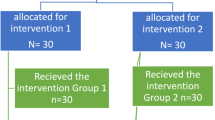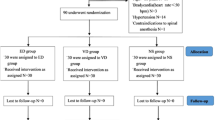Abstract
The loss of benefit from intrathecal baclofen, with increased spasticity and a discrepancy between the residual and the calculated volume content (underinfusion), made us suspect dysfunction of the intrathecal baclofen infusion in a paraplegic patient. Although all possible usual checking methods were used, no failure in the drug administration device (DAD) could be found. Despite some benefit from increasing the daily dose of baclofen, it has not been possible to control the spastic symptoms. Surgery was therefore decided upon, and a small leak at the end of the catheter tip was discovered. Surgeons and physicians should be aware that checking methods of DAD cannot exclude failure of the system. Their errors and limitations are discussed.
Similar content being viewed by others
Log in or create a free account to read this content
Gain free access to this article, as well as selected content from this journal and more on nature.com
or
References
Penn R D, Kroin J S (1984) Intrathecal baclofen alleviates spinal cord spasticity. Lancet 1: 1078 (letter).
Lazorthes Y, Sallerin-Caute B, Verdie J C, Bastide R, Carillo J P (1990) Chronic intrathecal baclofen administration for control of severe spasticity. J Neurosurg 72(3): 393–402.
Penn R D (1992) Intrathecal baclofen for spasticity of spinal origin: seven years of experience. J Neurosurg 77(2): 236–40.
Loubser P G, Narayan R K, Sandin K J, Donovan W I H, Russell K D (1991) Continuous infusion of intrathecal baclofen: Long term effects on spasticity in spinal cord injury. Paraplegia 29(1): 48–64.
Eddy P, Jamous A, Gardner B, Wang D, Silver J (1992) Complications of intrathecal drug delivery. Br J Neurosurg 6(2): 115–8.
Delhaas E M, Brouwers J R (1991) Intrathecal overdose: Report of 7 events in 5 patients and review of the literature. Int J Clin Pharmacol Ther Toxicol 29(7): 274–80.
Zierski J, Muller H, Dralle D, Wurdinger T (1988) Implanted pump systems for treatment of spasticity. Acta Neurochir Suppl (Wien) 43: 94–9.
Medtronic (1987): Users' Guide to Medtronic Synchromed Infusionsystem. Medtronic Inc, Minneapolis.
Kroin J S, Penn R D, Beissinger R L, Arzbaecher R C (1984) Reduced spinal reflexes following intrathecal baclofen in the rabbit. Exp Brain Res 54: 191–19.
Penn R D, Kroin J S (1985) Continuous intrathecal baclofen for severe spasticity. Lancet 2: 125–127.
Hankey G J, Stewart-Wynne E G, Perlman D (1986) Intrathecal baclofen for severe spasticity. Med J Aust 145: 465–466.
Lazorthes Y (1987) Chronic intrathecal administration of baclofen in treatment of severe spasticity. In: Müller H, Zierski J, Penn RD, editors. Local Spinal Therapy of Spasticity. Springer-Verlag, Berlin: 215–222.
Siegfried J, Rea G L (1987) Intrathecal application of baclofen in treatment of spasticity. Acta Neurochir Suppl 39: 121–123.
Penn R D, Kroin J S (1987) Long term intrathecal baclofen infusion for treatment of spasticity. J Neurosurg 66(2): 181–5.
Ochs G, Struppler A, Meyerson B A, Linderoth B, Gybels J, Gardner B P et al. (1989). Intrathecal baclofen for long-term treatment of spasticity. A multicenter-study. J Neurol Neurosurg Psychiatry 52(8): 933–9.
Ochs G, Delhaas E M (1992) Spasticity management with the Synchromed™ Infusion System. In: The Synchromed™ Infusion System. Medtronic Inc (Schweiz), Dübendorf.
Author information
Authors and Affiliations
Rights and permissions
About this article
Cite this article
Schurch, B. Errors and limitations of the multimodality checking methods of defective spinal intrathecal pump systems. Case report. Spinal Cord 31, 611–615 (1993). https://doi.org/10.1038/sc.1993.97
Issue date:
DOI: https://doi.org/10.1038/sc.1993.97
Keywords
This article is cited by
-
Wenn die „Pumpe“ versagt...
Trauma und Berufskrankheit (2010)
-
Neurologische Komplikationen und Wirkverlust unter intrathekaler Schmerztherapie
Der Schmerz (2005)



